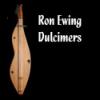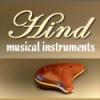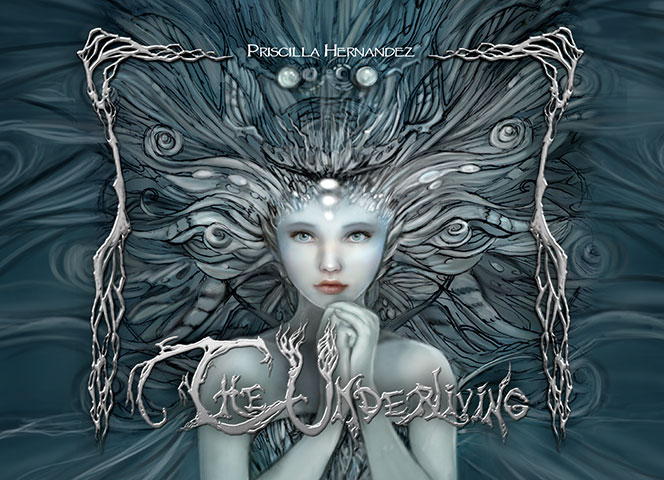Bulgarian Gadulka or Balkan Fiddle: A bowed string instrument similar to the Rebec and Greek Lyre
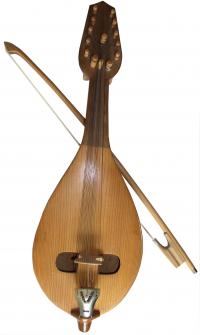
The name means "to make noise, hum or buzz". The gadulka is an integral part of Bulgarian traditional instrumental ensembles, commonly played in the context of dance music. Sometimes referred as the "Balkan fiddle"
sample mp3(streamed from balkanfolk.com ) so you can make an idea how it sounds like
The resonance chamber is pear shaped similar to a lute forming a bowl or gourd and it's often carved out of a single piece of wood. The player holds it up right hanging from the belt or on the lap if sitting. Of byzanthine procedence it is rather similar to the Greek lyre. Gadulka strings are steel, either plain in the smaller gauges or wound with steel or bronze in the larger ones; they are basically guitar strings. The strings are secured to the tailpiece by their ball ends!It has three melody strings and up to 16 strings thinner metallic steel sympathetic strings that make resonance upon the tones, making the gadulka sounds more clear (the natural sound of gadulka is quieter than the violin though less crispy and pleasant to the ear). The strings are played with the nails. The tone of the gadulka is obtained by gliding the strings with the bow made of flexible forked willow twig and tied with horse hair and waxed with rosin.
Unlike many other stringed instruments, there is no nut at the top of the strings: the strings are simply stretched between a tuning peg at the top and the tailpiece at the bottom, passing over the bridge (the playing strings) or through holes in the bridge (the sympathetics). The tailpiece is typically made out of bone, and secured to the carved projecting "end pin" by stout steel wire. The end pin also serves to hold the bottom of the instrument to a strap or belt worn by the player. It is bowed with an underhand grip.The top (soundboard) is also carved with a shallower arch. The overall construction is quite heavy compared to, say, a violin, though some gadulkas are exquisitely built. The instrument generally lacks any real decoration or ornamentation, apart from the design of the peg head.
For more information we recommend to read as always the Gadulka wikipedia article
In Bulgaria it's used in folk traditional and ritual songs.Though apparently crude and unwieldy, this instrument is capable of great heights of technique and sensitivity in the hands of such masters as Nikola Parov, Giorgi Petrov or Mihail Marinov. In Bulgaria it is usually played in ensembles with the kaval (end-blown flute), gaida (bagpipe) and tambura (a type of guitar) or tapan (a large drum). Dance rhythms range from the relatively straightforward 7/8; to the 11/8 Kopanitsa to even 22/16
Tuning
While various tunings are (and have been) used, the standard tuning for the gadulka is A-E-A for the three melody strings a pitch that gives more opportunities for solo instrumental performances but the tuning differ in different regions; the sympathetics (resonating strings) are tuned chromatically to cover all notes besides A and E
The 3 stringed Gadulka is pitched normally in these different regional ways: Thracia tuning: 1st string – A1 2nd string –E1 3rd string – A, Dobrudja tuning: 1st string – A1 2nd string – A 3rd string – E1 or Lingourie tuning: 1st string – A1 2nd string – E1 3rd string – D1

Example of gadulka tuning with three melody string (black) and 10 resonance strings (in red)
Only the upper strings are bowed while the other strings accompany only to resonate the sound rendering that echo-like haunting sound of the instrument.
Teaching yourself..?
We recommends "The Gadulka book" a book that includes the history of the instrument, its regional types, shapes, tuning scales and techniques including a lot of graphical material for easy learning. You can purchase this book from the store at Folk Factory.
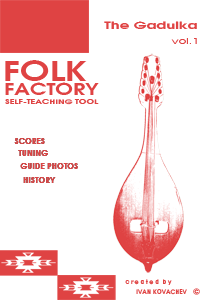
Below you can see a video of a gadulka being played
Where to buy
In ebay you can find some gadulkas listed, from kid very cheap ones to actually playable instruments. Be sure you don't buy a souvenir one, that can go really cheap but though make sounds are not ready to be played.
- Ebay (here you can find a few playable ones for quite a bargain price... but beware souvenirs!!)
Check also these stores, they specializes in Bulgaria culture and instruments and list them :)

Above: Gadulka available at Balkan folk
I don't know the quality of these instruments or if they're playable, so I recommend to contact the sellers directly before purchasing, they are just links I've found when looking for gadulkas for myself. Hope to have one soon to make a proper review. We´ll keep on adding information about instructional material and where to buy them on future updates.
Need more inspiration?
Visit the website of the master gadulka player of traditional Bulgarian music Nikolay Kolev
- Login to post comments


